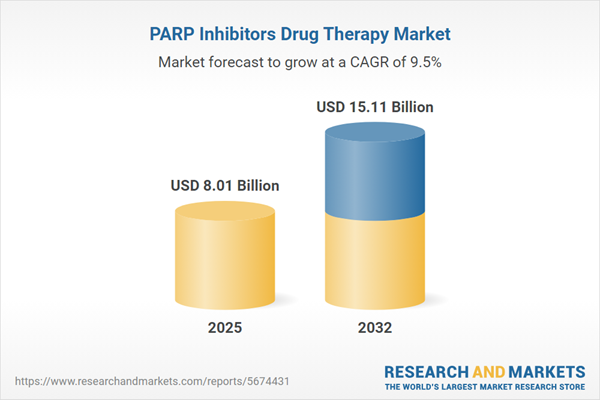Speak directly to the analyst to clarify any post sales queries you may have.
PARP inhibitors drug therapy is reshaping the precision oncology sector, opening new paths for personalized cancer management and adaptive care strategies. As regulatory, clinical, and reimbursement frameworks continuously evolve, healthcare leaders require timely insight to secure enduring growth and competitive advantage in the PARP inhibitors drug therapy market.
Market Snapshot: PARP Inhibitors Drug Therapy Market
The PARP inhibitors drug therapy market is experiencing significant expansion, marked by routine use in oncology and a surge of innovative therapies progressing through a robust pipeline. As these agents move from trials to established practices, adoption rates are climbing among diverse patient groups. Ongoing launches of novel agents, alongside integration of companion diagnostics, are refining patient selection, fostering more effective treatment, and enhancing operational efficiency. The market is further supported by reimbursement models that adapt to therapy value and the broadened role of PARP inhibitors across multiple cancer types. Globally, commercial prospects are accelerating, driven by regulatory initiatives in developed and emerging medical economies dedicated to greater access to advanced therapies.
Scope & Segmentation: Executive Framework for Informed Decisions
This report provides targeted segmentation for senior executives to underpin strategic planning and resource allocation. Each segment delivers actionable intelligence to guide oncology business portfolios:
- Indication: Examination of cancer types such as breast, ovarian, pancreatic, and prostate, with insights into critical patient subgroups including hormone receptor-positive, triple negative, BRCA-mutant, HRD, and non-HRD populations to tailor precision therapy approaches.
- Drug: Analysis of use patterns for niraparib, olaparib, rucaparib, and talazoparib, providing comprehensive perspectives on real-world adoption and formulary decision drivers.
- Line of Therapy: Coverage of therapy across initial, maintenance, and sequential lines, guiding integration of clinical advances into evolving standards of care.
- Treatment Setting: Review of both inpatient and outpatient delivery, emphasizing efficient workflows and collaborative oncology care environments.
- End User: Overview of hospitals, retail pharmacies, and specialty clinics to address the shifting models for therapy distribution and engagement.
- Distribution Channel: Insights into logistics across hospital, online, and retail pathways, highlighting streamlining and cost-effectiveness opportunities.
- Therapy Type: Evaluation of monotherapy versus combination regimens, aligned with changing evidence and optimizing patient outcomes.
- Patient Age Group: Assessment of adult and elderly patient groups to support precise regulatory compliance and strategy refinement.
- Geographic Coverage: Review of Americas, Europe, Middle East and Africa, and Asia-Pacific, including healthcare policy, payer diversity, and local growth drivers.
- Company Profiles: Profiles of leading pharmaceutical firms such as AstraZeneca, GlaxoSmithKline, Clovis Oncology, Pfizer, and Merck, with competitor perspectives and analysis of partnering trends.
Key Takeaways for Senior Leadership
- Widening patient access to PARP inhibitor therapies is enhancing precision medicine across integrated treatment settings.
- Interorganizational collaboration grows as combination therapy protocols necessitate tighter partnerships and improve patient management pathways.
- Incorporation of next-generation sequencing with real-world analytics enables more accurate patient identification and shorter innovation cycles, supporting quicker clinical and organizational decisions.
- Partnerships between pharmaceutical and diagnostic companies are clarifying regulation and sharpening patient selection, making precision oncology more feasible and efficient.
- Innovations in maintenance therapy protocols contribute to greater consistency in outcomes and care across diverse clinical environments.
- Ongoing transition toward value-driven reimbursement models calls for high-quality data, challenging organizations to build adaptable, responsive commercial strategies.
Tariff Impact: Navigating U.S. Policy Dynamics
Recent changes to U.S. tariffs are altering pricing frameworks for PARP inhibitors and related diagnostics. Pharmaceutical organizations are revisiting supply chain and operational approaches to address new cost realities. These shifts are impacting negotiations with payers while elevating the importance of agile value-based reimbursement models. Regulatory updates continue to shape pricing and supply decisions in the U.S. market for PARP inhibitors drug therapy.
Methodology & Data Sources
This report synthesizes direct insights from industry leaders, payer groups, and oncology centers of excellence. Findings are validated with structured secondary research and regulatory analysis to ensure market intelligence is aligned with current trends in oncology practice and data standards.
Why This Report Matters
- Empowers executive decision-makers to refine oncology portfolios and drive commercial growth within the competitive PARP inhibitors drug therapy market.
- Supports organizations with strategic analysis, enabling swift response to clinical, regulatory, and payer shifts as they emerge.
- Drives efficient deployment of resources and strengthens competitive positioning through targeted operational intelligence for advanced oncology landscapes.
Conclusion
This report translates complex oncology market data into practical guidance for senior leaders, enabling confident strategies and opportunity capture as the PARP inhibitor therapy landscape evolves.
Additional Product Information:
- Purchase of this report includes 1 year online access with quarterly updates.
- This report can be updated on request. Please contact our Customer Experience team using the Ask a Question widget on our website.
Table of Contents
3. Executive Summary
4. Market Overview
7. Cumulative Impact of Artificial Intelligence 2025
Companies Mentioned
The companies profiled in this PARP Inhibitors Drug Therapy market report include:- AstraZeneca PLC
- GlaxoSmithKline PLC
- Clovis Oncology, Inc.
- Pfizer Inc.
- Merck & Co., Inc.
Table Information
| Report Attribute | Details |
|---|---|
| No. of Pages | 180 |
| Published | November 2025 |
| Forecast Period | 2025 - 2032 |
| Estimated Market Value ( USD | $ 8.01 Billion |
| Forecasted Market Value ( USD | $ 15.11 Billion |
| Compound Annual Growth Rate | 9.4% |
| Regions Covered | Global |
| No. of Companies Mentioned | 6 |









